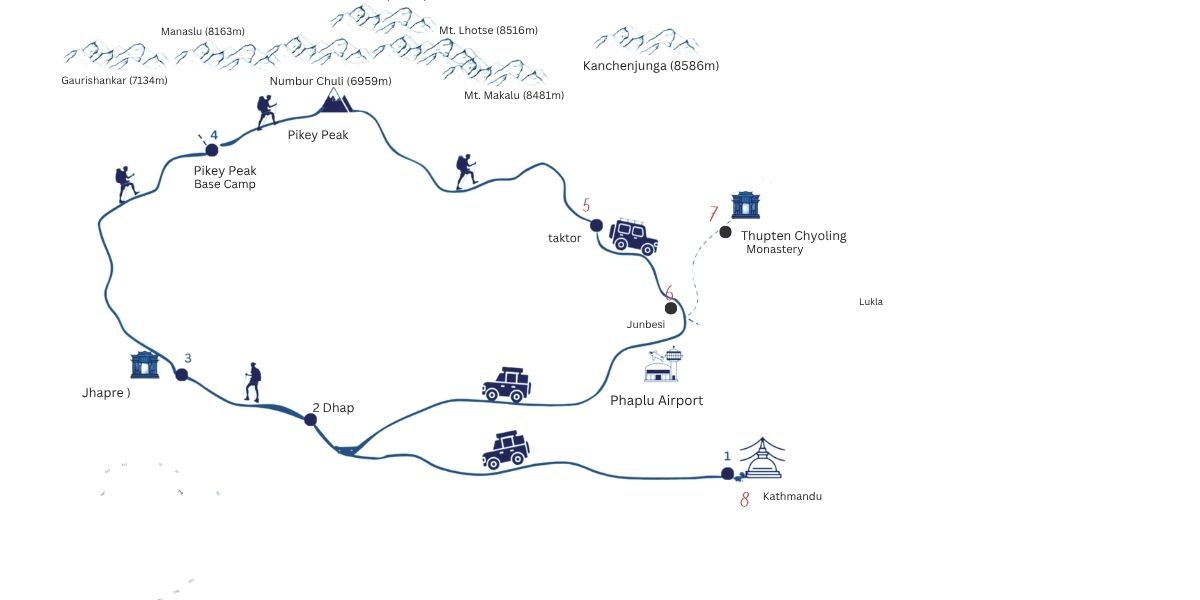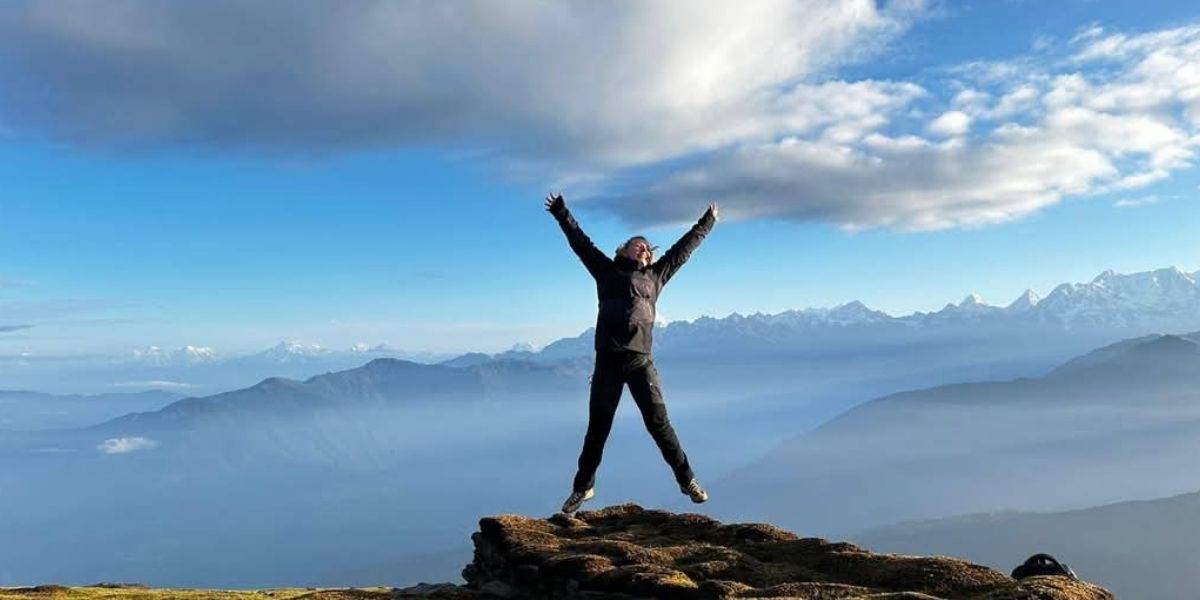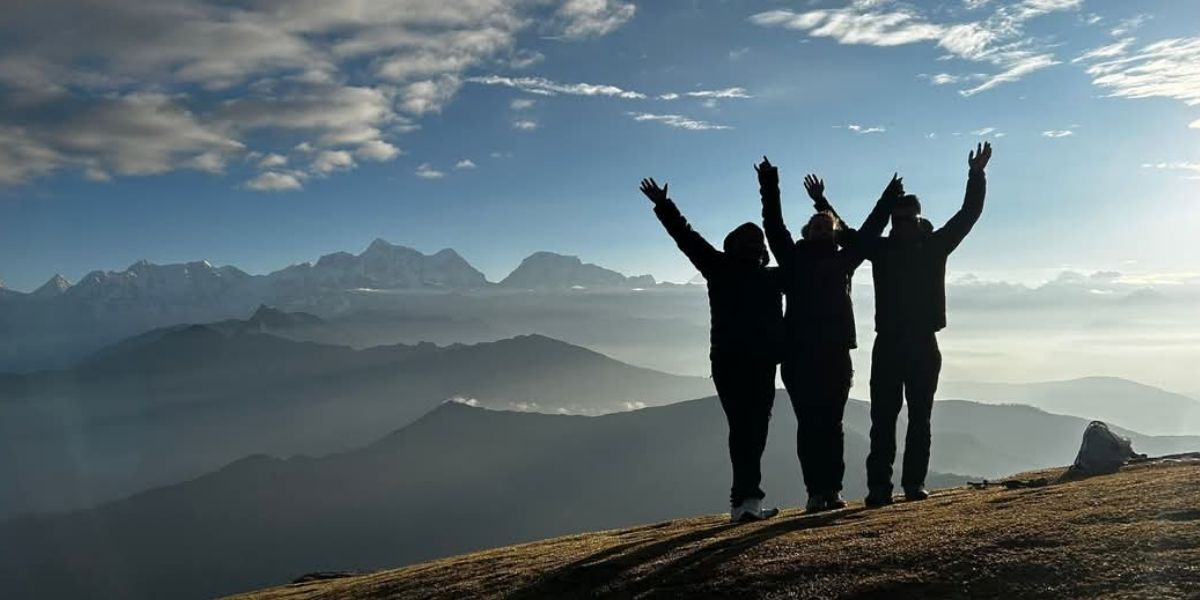In this blog, we provide you with key insights into the Pikey peak trek map, including elevation and altitude details, itinerary and elevation breakdown, and preparation for the Pikey peak trek. So, keeping this in mind, let’s get started!
Table of Content
Nepal is a dream destination for trekkers as this name is home to some of the best trekking trails in the world. Among many such trekking routes, the Pikey Peak trek is one of the most popular ones. This trekking trail rises to an elevation of 4,065 meters (13,336 feet), making it one of the most stunning panoramic views in Nepal. This includes a rare southern view of Mount Everest. So whether you are a seasoned trekker or a first-time adventurer, understanding this Pikey Peak trek map allows you to go on this trek without any form of worry.
In this blog, we provide you with key insights into the Pikey peak trek map, including elevation and altitude details, itinerary and elevation breakdown, and preparation for the Pikey peak trek. So, keeping this in mind, let’s get started!
Understanding the Pikey Peak Trek Map

The Pikey Peak trek map provides you with a clear and detailed outline of the journey from Kathmandu and Pikey Peak, passing through the remote and culturally rich areas of the Solu region. This trek begins with a drive from the capital to the Dhap, which gradually leads you to the highlands. As you follow the route, you shall pass through key villages such as Jhapre, Taktor, and Jhunbesi. Each of these villages offers you a unique glimpse into the local sherpa life. Furthermore, the Pikey Peak trek map highlights the progression into elevation, helping trekkers anticipate altitude changes and prepare accordingly.
In addition to the trail, the map also features important landmarks such as rivers, rhododendron forests, and pastures. Some of the notable cultural sites that may be mentioned on the map include Thupten Chholing and Chiwong Monasteries, offering both spiritual and scenic stops along the way, with stunning panoramic views of Everest, Kanchenjunga, and other Himalayan giants. The map of Pikey Peak is not just a navigational tool; rather, it is a window into the natural and cultural richness which defines the beaten-off path adventure.
Elevation and Altitude Details of Pikey Peak
While reading the map of Pikey Peak, it is important to note down the elevation and altitude details of this peak. That said, the specific details of altitude depend on the package. However, we can provide you with a general outline regarding the elevation and altitude of the Pikey peak. Following is the general outline regarding the elevation and altitude of Pikey Peak:
- Kathmandu (1,400 m): The trek begins in the capital city at a moderate altitude.
- Dhap (2,900 m): After a long drive, you arrive at Dhap, marking the start of the highland terrain.
- Jhapre (2,920 m): A short trek from Dhap brings you to Jhapre with minimal elevation gain.
- Pikey Base Camp (3,640 m): The altitude rises steadily as you reach the base camp nestled beneath the peak.
- Pikey Peak (4,065 m): The highest point of the trek offers stunning views of the Himalayan range.
- Taktor (2,950 m): After summiting, the trail descends sharply to the village of Taktor.
- Junbesi (2,700 m): The route continues downhill through cultural villages and scenic trails.
- Phaplu (2,400 m): The trek ends in Phaplu, where the altitude is much lower and more comfortable.
Pikey Peak Trek Itinerary and Elevation Breakdown

Knowing the pikey peak map is ideal. But alongside learning the itinerary and elevation of Pikey Peak, it is a good idea to know about the trek itinerary and elevation as well. While the specific itinerary depends on the package, we can provide you with a general outline of the itinerary and elevation. Following is a general breakdown of the package itinerary based on the package from Himalayan Odyssey:
Day 1: Arrival at Kathmandu (1,400 m)
Your trek begins with your arrival in the vibrant capital of Nepal, Kathmandu. After completing immigration and customs formalities, our representative will greet you outside the airport and take you to your hotel. This first day allows time for you to acclimatize, recover from your flight, and prepare yourself and your body for the trek ahead.
Day 2: Journey from Kathmandu to Dhap (2,900 m)
Leaving the chaos of Kathmandu, you will embark on an 8-hour journey to Dhap, which has calming winds along mountain roads, traversing Okhaldhunga and traversing the Sun Koshi in front of the deafening Koshi River. As the altitude increases, the landscape changes to rolling hills, picturesque villages, and forests of rhododendrons. Upon reaching Dhap, you’re welcomed by fresh mountain air and, if the skies are clear, a stunning view of Number Chuli Peak.
Day 3: Trek from Dhap to Jhapre (2,920 m)
The route begins gradually, leading you along ridgeline forests and through the village of Sigane to Jhapre. Jhapre is situated on a ridge and is tranquil, with wonderful Himalayan vistas, including the occasional look at Everest and the surrounding peaks. The village is dotted with houses and small monasteries, and it is still a peaceful spot in which to absorb the surroundings.
Day 4: Jhapre to Pikey Base Camp (3,640 m) trek
After an early start, you gradually ascend through luscious pine and rhododendron woods. Walkers in spring will be gifted with a tapestry of colour by blooms. The trail takes you through Bhulbule and the grazing grounds of Lhamuje, where yaks and shepherds will necessarily cross your path. The latter part of Pikey Base Camp is made up of a series of zig-zagging uphill ascents but is repaid with tranquillity and build-up anticipation for the next day's summit attempt.
Day 5: Pikey Peak hike (4,065 m) and trek to Taktor (2,950 m)
Early morning rise and hike the hour-long ascent to Pikey Peak. Enjoy a breathtaking sunrise and one of the broadest, most sweeping Himalayan views to be found—from Everest and Kanchenjunga to Dhaulagiri and Gaurishankar. Having enjoyed this breathtaking perspective, you'll begin your trek down across ridges and woods, eventually arriving in Taktor, a peaceful village surrounded by greenery and adorned with scattered chortens.
Day 6: Hike from Taktor to Junbesi (2,700 m)
This day’s hike is an easy one, and much of it is flat, along serene forest trails lined with Mani walls and prayer flags. You arrive in Junbesi, one of the most culturally rich villages in the area, and the location of the stunning Thubten Chholing Monastery. It was founded in the 19th century and is still a functional spiritual centre with hundreds of nuns and monks.
Day 7: Junbesi to Phaplu trek via Chiwong Monastery (2,400 m)
On the final day of your trek, you trek from Junbesi to Phaplu and visit the revered Chiwong Monastery, perched dramatically on a cliff face. The trail winds through forest and ridge before descending into the valley where Phaplu is located. This is the highlight of your trekking adventure and a time to reflect upon your incredible trek.
Day 8: Vehicle Drive from Phaplu to Kathmandu (1,400 m)
You will drive back to Kathmandu in a vehicle after traversing through beautiful valleys and rural hills on your way back. Upon arriving back at the capital city, you will be transferred to your hotel, and you will be able to get a well-deserved rest and perhaps have a celebratory night meal out in Thamel.
Day 9: Last Departure
On your final day, you will be transported to the international airport three hours before your flight. With memories in your heart of the mountains and peaceful trails you bid Nepal a goodbye until you visit again.
Preparation Tips for Pikey Peak Trek

Preparing for the Pikey Peak trek is not just about knowing the itinerary - you must also have extra information regarding preparation as well. While there are a wide range of preparation tips, some of the key ones include:
- Build your physical fitness with regular cardio, leg-strengthening exercises, and practice hikes to improve stamina and endurance.
- Pack layered clothing to adapt to changing weather, including moisture-wicking base layers, insulating mid-layers, and windproof/waterproof outerwear.
- Stay hydrated and pace yourself to acclimatize properly, especially since the trek reaches over 4,000 meters.
- Use trekking poles for stability on uneven terrain and carry a good-quality daypack for essentials like snacks, water, and extra layers.
- Obtain comprehensive travel insurance that covers high-altitude trekking, medical evacuation, and trip cancellations.
- Respect local culture by dressing modestly, asking permission before photographing people, and avoiding littering.
- Consider booking a local guide or trekking agency to enhance your experience with cultural insights and logistical support.
- Plan your trek during spring (March to May) or autumn (September to November) for the best weather, clear skies, and beautiful rhododendron blooms.
Conclusion
Pikey peak trek offers you with an ideal blend of breathtaking Himalayan panoramas, rich cultural experience, and a diverse range of natural beauty. Its altitude is manageable, and with a well-planned itinerary, the Pikey Peak is ideal for you regardless of if you are a novice or an experienced trekker. However, before going on this trek, you should be well aware of the pikey peak trek map. Furthermore, you should also know altitude details and prepare properly before you head forward on this trek as well. Whether you’re captivated by the stunning mountain views, vibrant Sherpa villages, or serene monasteries, Pikey Peak promises an unforgettable adventure that stays with you long after you descend. Embark on this trek well-prepared, with the best tour and travel operator for Pikey Peak in Nepal.
FAQ Pikey Peak Trek Map: Elevation, Height & Altitude Guide
What is the altitude of Pikey Peak?
Pikey Peak stands at an elevation of 4,065 meters (13,336 feet) above sea level. It offers one of the best panoramic viewpoints in the lower Everest region.
How hard is Pikey Peak?
Pikey Peak is considered a moderate trek suitable for beginners with good physical fitness. The trail involves gradual ascents and descents, with the main challenge being the altitude.
What mountains can you see from Pikey Peak?
From the summit, you can witness a sweeping view of Everest, Kanchenjunga, Dhaulagiri, Makalu, Manaslu, and other Himalayan peaks. The sunrise from the top offers an especially stunning spectacle of these mountains.
Is Pikey Peak worth it?
Yes, Pikey Peak is absolutely worth it for those seeking a less-crowded trail with rich culture, scenic beauty, and striking Himalayan views. It provides a rewarding trekking experience without the need for extreme altitude acclimatization.
How to reach pikey peak?
To reach Pikey Peak, you typically take a drive from Kathmandu to Dhap, followed by a multi-day trek through villages like Jhapre and Junbesi. The route gradually ascends to Pikey Base Camp before summiting the peak.


